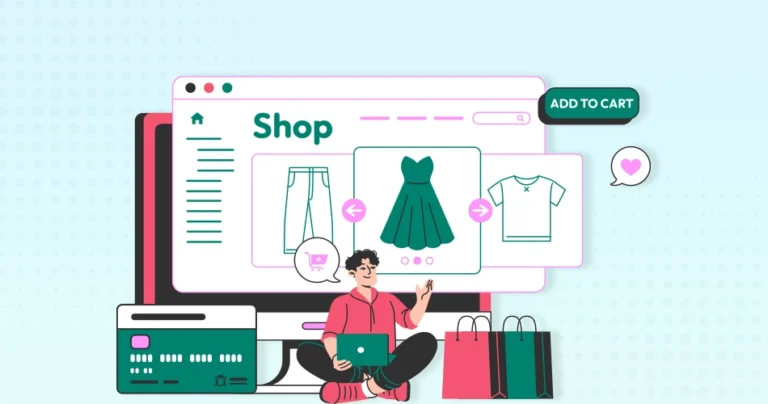One thing you should know when you’re running an online store is that you need more than just good products. The way your website looks directly impacts sales. If shoppers find your site confusing, slow, or outdated, customers won’t stick around, no matter how great your products are.
Customers expect fast, easy, and secure shopping experiences. When your website falls short, trust drops and sales slip through the cracks. The reality is that even small design mistakes can quietly cost you revenue every single day.
In this blog, we will discuss the top eCommerce website design mistakes to avoid if you want more conversions. More importantly, you’ll learn how to fix them so your store feels professional, builds trust, and converts more visitors into loyal buyers. So, let’s start!
Why Good Design Matters in eCommerce
When we speak of good design, we are not talking just about how beautiful your site looks. There’s more than that. Good design is about making potential customers spend more time on the site and making them buy stuff.
First Impressions Help Build Trust and Credibility
When someone lands on your online store, their first impression is instant. A clean, modern design makes your business look trustworthy. A cluttered or outdated design does the opposite. If your site doesn’t feel professional, shoppers may doubt your products or even the safety of buying from you.
Direct Impact on Conversion Rates and Order Value
Good design is not just about looks. It guides visitors to take action, whether that’s adding items to their cart or completing checkout. A smooth design removes friction and makes shopping easy. The easier the process, the more likely customers are to buy and often spend more per order.
User Experience Builds Retention and Loyalty
Design also shapes the overall experience of your store. Clear navigation, fast loading, and mobile-friendly layouts make customers want to return. The chances of buyers coming back to your store increase when shopping feels easy and pleasant, and they will even recommend your store to others.
In short, design is more than visuals. It builds trust, boosts sales, and keeps customers coming back. That’s why avoiding design mistakes should be a top priority for any eCommerce business. To get it right from the start, it’s smart to hire Ecommerce developers who can build a site that is clean, user-friendly, and built to convert.
Common eCommerce Website Design Mistakes (and Fixes)
Now that you understand the importance of good eCommerce design, you can proceed. Let us discuss some of the most common mistakes to avoid.
Cluttered or Overwhelming Homepage
A homepage that shows too much at once can confuse shoppers. When visitors see multiple banners, pop-ups, and too many product options, they don’t know where to look. This creates decision fatigue and makes people leave before exploring your store. A messy homepage often feels unprofessional and lowers trust.
Fixes:
- Keep the layout clean and simple.
- Highlight one main offer or featured product.
- Use clear headings and focused calls to action.
- Limit pop-ups and distracting elements.
Poor Navigation & Site Structure
If customers can’t find what they need quickly, they’ll leave. Confusing menus, too many categories, or unclear labels create frustration. Visitors don’t have time to “figure out” your site. A poor site structure makes the whole shopping journey harder.
Fixes:
- Use simple and clear menu labels.
- Organize products into logical categories.
- Add a visible search bar on every page.
- Limit menu depth to 2–3 levels max.
Slow Loading Speed
Slow websites are a sales killer. Shoppers expect pages to load in seconds. A delay of even a few seconds can make people abandon your site. Search engines also penalize slow websites, so you lose both customers and rankings.
Fixes:
- Compress and optimize images.
- Remove unused apps, scripts, or plugins.
- Choose reliable hosting with good speed.
- Use a content delivery network (CDN).
Weak Mobile Experience
A big chunk of overall digital spending comes from mobile commerce. If your site is broken on phones or hard to navigate, you’re losing a significant share of potential customers. Pinching and zooming frustrate shoppers, making checkout a painful experience.
Fixes:
- Use a responsive design for all devices.
- Test your site on different screen sizes.
- Keep menus and buttons thumb-friendly.
- Make checkout mobile-optimized and simple.
Inconsistent Branding & Design Elements
When fonts, colors, and layouts don’t match, your store feels unprofessional. Customers notice the lack of consistency and may question whether the site is reliable. Inconsistent design weakens your brand identity and makes your store forgettable.
Fixes:
- Stick to 2–3 brand colors and fonts.
- Use consistent button and heading styles.
- Keep a uniform tone across all visuals.
- Create a simple brand style guide.
Poor Product Pages
Product pages are where sales happen, but many sites treat them as an afterthought. Weak images, vague descriptions, and missing details push shoppers away. Without enough information, buyers hesitate and abandon the page.
Fixes:
- Use high-quality images with zoom options.
- Write clear, benefit-driven product descriptions.
- Add key details like size, material, or specs.
- Include reviews, FAQs, and social proof.
Complicated Checkout Process
A long or confusing checkout kills sales. Extra steps, forced account creation, or hidden costs frustrate buyers. Cart abandonment often happens here, even when customers are ready to buy.
Fixes:
- Allow guest checkout with no forced signup.
- Show progress with simple step indicators.
- Keep forms short and only ask for essentials.
- Offer multiple payment and shipping options.
Lack of Trust Signals
Shoppers won’t spend money if they don’t trust your site. Missing reviews, unclear return policies, or a lack of security signals raise doubts. In eCommerce, even small trust gaps can cost big sales.
Fixes:
- Show SSL and secure payment badges.
- Display clear return and shipping policies.
- Add customer reviews and testimonials.
- Highlight guarantees like “Money Back” or “Free Returns.”
Ignoring Accessibility
Many websites overlook accessibility, locking out customers with disabilities. Poor contrast, unreadable fonts, or missing alt text make shopping harder. Ignoring accessibility can also lead to legal risks in some regions.
Fixes:
- Use easy-to-read fonts and proper color contrast.
- Add alt text to all product images.
- Ensure the site works with screen readers.
- Design buttons and forms for easy interaction.
Neglecting SEO in Design
A great-looking site is useless if no one can find it. Ignoring SEO basics during design means fewer visitors. Poor site structure, missing keywords, or unoptimized images hurt search rankings and limit growth.
Fixes:
- Optimize titles, meta descriptions, and product URLs.
- Use keyword-rich headings where relevant.
- Compress and name images properly.
- Keep the site structure simple for search engines.
Simply put, common eCommerce website design mistakes, such as cluttered layouts, poor navigation, slow speed, or weak product pages, can quickly drive shoppers away. By fixing these issues with simple design improvements, you can build trust, boost sales, and create a smoother shopping experience.
Ready to build an eCommerce site that converts?
Best Practices for Effective eCommerce Web Design
Good design is not just about avoiding mistakes. It’s also about following proven practices that make shopping simple and enjoyable for your customers. Here are some key ways to design an online store that feels professional and drives more sales.
- Prioritize user-first design: Your website should be built around the needs of your shoppers, not just what looks nice. Every click, menu, and button should guide customers smoothly toward buying. If the design feels easy, people stay longer and buy more.
- Test across devices and browsers: Shoppers use phones, tablets, and computers with different browsers. What looks perfect on one screen may break on another. Regular testing ensures your site works everywhere and provides all customers with a smooth experience.
- Use heatmaps and A/B testing to refine layout: Guessing what works is risky. Heatmaps show where users click or scroll the most, while A/B testing compares two versions of a page to see which performs better. Using these tools helps you improve design based on real shopper behavior.
- Regularly update and optimize product pages: Your product pages are the heart of your store. If details are outdated or images are poor, sales drop. Keep product descriptions, photos, and reviews fresh. Optimized product pages build trust, answer questions, and help you rank better on search engines.
In short, effective eCommerce design is about putting users first, testing across devices, and improving based on real shopper behavior. Regular updates to product pages keep your store professional, trustworthy, and ready to convert more visitors into buyers. If you want to take this further, then partner with an eCommerce development company.
Conclusion
Good eCommerce design is more than just looks. It shapes how customers feel about your store and whether they trust you enough to buy. Even small mistakes in design can quietly cost sales and push shoppers to competitors.
Most of these mistakes are easy to fix. By keeping your site clean, simple, and user-friendly, you create a shopping experience that builds trust and drives sales. Testing your site often and updating product pages regularly will also keep your store professional and competitive. Remember that designing is an ongoing process that needs attention as your business grows and customer needs change. If you’re not sure where to start or feel your store needs a professional touch, you can get in touch with our experts!
FAQs
Q1. What are the most common problems in website design?
The most common problems include cluttered layouts, confusing navigation, slow loading speed, weak mobile experience, and poor product pages. These issues make shopping harder for customers and often lead to lost sales.
Q2. What are the most problematic mistakes designers make?
The biggest mistakes are focusing too much on looks instead of usability, ignoring mobile design, and skipping trust signals like reviews or secure payment icons. These errors reduce trust and make customers leave before buying.
Q3. How do I improve my website design?
Start by keeping the design clean and simple. Test your site on different devices, improve page speed, and make checkout easy. Updating product pages with clear images and descriptions also helps build trust and boost sales.
Q4. What are the features of a bad website design?
A bad design feels messy, slow, and hard to use. It often has poor navigation, inconsistent branding, and missing details on product pages. If a website frustrates customers instead of guiding them, it’s a bad design.





